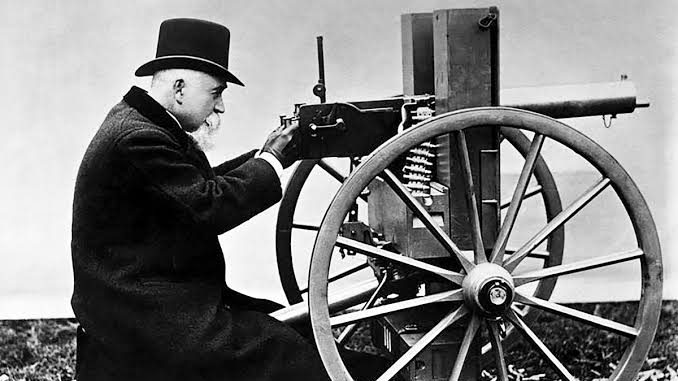When Hiram Maxim, an American-born British inventor, introduced the Maxim gun in 1884, he unknowingly set the stage for a new era in warfare—one that would lead to some of the deadliest conflicts in human history. The Maxim gun, the first fully automatic machine gun, was revolutionary in its ability to fire continuous rounds with unprecedented speed and efficiency. This invention, while a marvel of engineering, quickly became a symbol of how technological advancements in weaponry could be leveraged to exert power on a global scale.

Maxim was not merely content with his invention; he was a shrewd businessman who understood the potential of his creation. He embarked on a global tour, demonstrating the lethal efficiency of the Maxim gun to governments across Europe and beyond. His efforts were remarkably successful—countries recognized that possessing this advanced weaponry could shift the balance of power in their favor. The Maxim gun was soon adopted by colonial powers, and it played a significant role in European imperial expansions, enabling relatively small armies to subdue much larger forces in Africa and Asia. The commercialization of such weaponry set a precedent for the future of the arms trade, where profit and power would become inextricably linked.
The Power of Weapons in International Relations
The proliferation of advanced weaponry, as exemplified by the Maxim gun, fundamentally altered the dynamics of international relations. Nations that possessed superior arms held a significant advantage over those that did not, and this imbalance often led to a militarized approach to diplomacy. The concept of “peace through strength” emerged, where nations believed that the possession of powerful weapons would deter adversaries from engaging in conflict. However, this also led to an arms race, where countries continuously sought to outdo each other in the development and acquisition of more sophisticated weapons.
In international relations, the power derived from weapons extends beyond mere military capability. It influences alliances, shapes geopolitical strategies, and determines the outcomes of conflicts. The arms trade became a tool for both deterrence and dominance, as countries used their military might to enforce their will on others or protect their interests. The export of arms became a strategic asset, allowing powerful nations to extend their influence across the globe by equipping allies and proxies with the means to wage war.
The Current State of Global Arms Trade
Today, the global arms trade is a multi-billion dollar industry, with the United States leading as the largest exporter of weapons. American arms are sold to over 100 countries, fueling conflicts and power struggles in various regions. The U.S. government often justifies these sales as necessary for maintaining global security, strengthening alliances, and promoting stability in volatile regions. However, the reality is far more complex.
The export of American weapons to countries embroiled in conflict, such as Saudi Arabia’s involvement in Yemen, has drawn significant criticism. These arms sales are seen as perpetuating violence, contributing to humanitarian crises, and destabilizing regions rather than promoting peace. Moreover, the strategic interests of the United States often come into conflict with human rights considerations, as weapons sold to certain regimes are used to suppress dissent and maintain authoritarian rule.
The global arms trade remains a powerful force in shaping international relations. Nations with advanced military industries, like the United States, Russia, and China, use their arms exports to secure strategic alliances and exert influence on the global stage. This trade is not just about selling weapons; it is about the transfer of power, the creation of dependencies, and the shaping of global order.
The commercialization of arms, which began with pioneers like Hiram Maxim, has had profound implications for global conflicts and international relations. The pursuit of profit in the arms industry has often outweighed concerns about the consequences of widespread weapon proliferation. As a result, the world continues to grapple with the deadly consequences of an arms race that shows no signs of abating. The lessons from the Maxim gun era remind us that the intersection of technology, commerce, and warfare can lead to devastating outcomes, a reality that is still very much relevant today.



